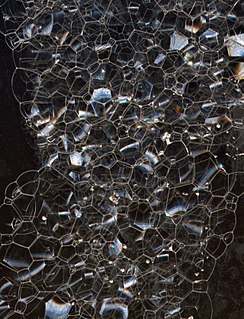
A mousse is a soft prepared food that incorporates air bubbles to give it a light and airy texture. It can range from light and fluffy to creamy and thick, depending on preparation techniques. A mousse may be sweet or savory.
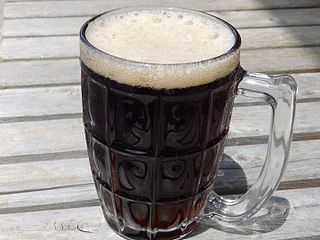
Root beer is a sweet North American soft drink traditionally made using the bark of the sassafras tree Sassafras albidum or the vine of Smilax ornata (sarsaparilla) as the primary flavor. Root beer may be alcoholic or non-alcoholic, most often non-alcoholic. It can be naturally free of caffeine or have caffeine added, and be carbonated or non-carbonated. It usually has a thick and foamy head when poured. Modern, commercially produced root beer is generally sweet, foamy, carbonated, non-alcoholic, and flavored using artificial sassafras flavoring. Sassafras root is still used to flavor traditional root beer, but since sassafras was banned by the U.S. Food and Drug Administration due to the carcinogenicity of its constituent safrole, most commercial recipes do not contain sassafras. Some commercial root beers do use a safrole-free sassafras extract. Major producers include A & W, Dr Pepper Snapple Group, Coca-Cola, Sprecher Brewery, Dad's Root Beer, Berghoff Beer, and Barq's.
Quantum foam or spacetime foam is the fluctuation of spacetime on very small scales due to quantum mechanics. The idea was devised by John Wheeler in 1955.
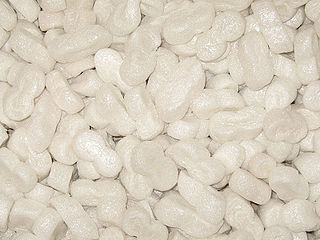
Foam peanuts, also known as foam popcorn, packing peanuts or packing noodles, are a common loose-fill packaging and cushioning material used to prevent damage to fragile objects during shipping. They are shaped to interlock when compressed and free flow when not compressed. They are roughly the size and shape of an unshelled peanut and commonly made of expanded polystyrene foam. 50–75 millimetres of peanuts are typically used for cushioning and void filling packaging applications. The original patent was filed for by Robert E. Holden in 1962 and was granted in 1965.
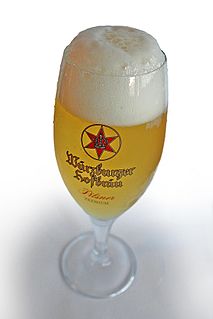
Beer head, is the frothy foam on top of beer which is produced by bubbles of gas, predominantly carbon dioxide, rising to the surface. The elements that produce the head are wort protein, yeast and hop residue. The carbon dioxide that forms the bubbles in the head is produced during fermentation. The carbonation can occur before or after bottling the beer. If the beer continues fermenting in the bottle, then it naturally carbonates and the head is formed upon opening and/or pouring the beer. If the beer is pasteurized or filtered then the beer must be force carbonated using pressurized gas.
Spumaretrovirinae, commonly called spumaviruses or foamyviruses, are a subfamily of the Retroviridae family. Spumaviruses are exogenous viruses that have specific morphology with prominent surface spikes. The virions contain significant amounts of double-stranded full-length DNA, and assembly is rather unusual in these viruses. Spumaviruses are unlike most enveloped viruses in that the envelope membrane is acquired by budding through the endoplasmic reticulum instead of the cytoplasmic membrane. Some spumaviruses, including the equine foamy virus (EFV), bud from the cytoplasmic membrane.

Microfoam is milk foamed using a steam wand on an espresso machine, used for making espresso-based coffee drinks, particularly those with latte art.

Smetana is one of the names for a range of sour creams from Central and Eastern Europe. It is a dairy product produced by souring heavy cream. It is similar to crème fraîche, but nowadays mainly sold with 9% to 36% milkfat content depending on the country. Its cooking properties are different from crème fraîche and the lighter sour creams sold in the US, which contain 12 to 16% butterfat. It is widely used in cooking and baking.
Human foamy virus (HFV) is a retrovirus and specifically belongs to the genus Spumavirus. The spumaviruses are complex and significantly different from the other six genera of retroviruses in several ways. The foamy viruses derive their name from the characteristic ‘foamy’ appearance of the cytopathic effect (CPE) induced in the cells.
Foamy virus in humans occurs only as a result of zoonotic infection.
The simian foamy virus (SFV) is species of the genus Spumavirus, which belongs to the family of Retroviridae. It has been identified in a wide variety of primates, including pro-simians, New World and Old World monkeys as well as apes, and each species has been shown to harbor a unique (species-specific) strain of SFV, including African green monkeys, baboons, macaques and chimpanzees. As it is related to the more well-known retrovirus Human Immunodeficiency Virus (HIV), its discovery in primates has led to some speculation that HIV may have been spread to the human species in Africa through contact with blood from apes, monkeys, and other primates, most likely through bushmeat hunting practices.
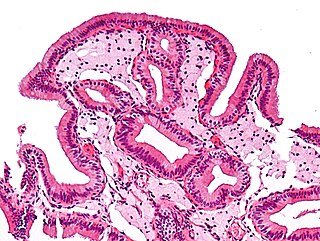
Foam cells are the fat-laden M2 macrophages that serve as the hallmark of early stage atherosclerotic lesion formation. As these plaques mature, they become more unstable and inflamed; blood clots triggered when an unstable plaque ruptures are the main driver of heart attack and stroke.

The moaning frog is a burrowing frog native to south-western Western Australia.
Foam is a substance that is formed by trapping gas bubbles in a liquid or solid.
Foam may also refer to:

A defoamer or an anti-foaming agent is a chemical additive that reduces and hinders the formation of foam in industrial process liquids. The terms anti-foam agent and defoamer are often used interchangeably. Commonly used agents are insoluble oils, polydimethylsiloxanes and other silicones, certain alcohols, stearates and glycols. The additive is used to prevent formation of foam or is added to break a foam already formed.

Rowntree's Randoms are a jelly sweet produced by Nestlé under its Rowntree's brand. The sweet was launched in the UK on 18 May 2009.

Touton giant cells are a type of multinucleated giant cell seen in lesions with high lipid content such as fat necrosis, xanthoma, and xanthogranulomas. They are also found in dermatofibroma.

Neurotically Yours is a comic book and webtoon created by Jonathan Ian Mathers. Both depict a goth girl named Germaine and her neurotic pet squirrel, Foamy. The webtoon series is ongoing, with publication every two weeks at Ill Will Press, YouTube, and Newgrounds.

Elephant's toothpaste is a foamy substance caused by the rapid decomposition of hydrogen peroxide by using potassium iodide as a reagent. How rapidly the reaction proceeds will depend on the concentration of hydrogen peroxide.
Because it requires only a small number of ingredients and makes a "volcano of foam", this is a popular experiment for children to perform in school or at parties; the experiment is also known as the "marshmallow experiment", but is unrelated to the psychological Stanford marshmallow experiment.
Bovine foamy virus (BFV) is a ss(+)RNA retrovirus that belongs to the genus spumaviridae. Spumaviruses are far different from the other six members of family retroviridae, both structurally and in pathogenic nature. Supma viruses derive their name from spuma the latin for "foam". The 'foam' part of 'foamy virus' comes from syncytium formation and the rapid vacuolization of infected cells which creates a 'foamy' appearance.
